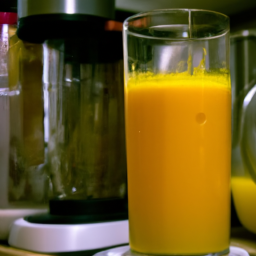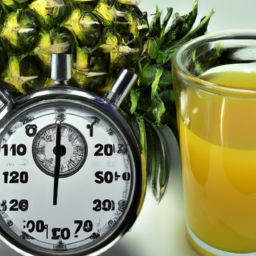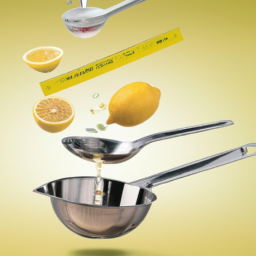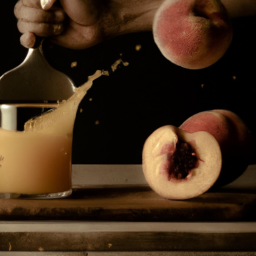If you are a health-conscious individual who likes to make your own juice, you may be wondering how long freshly prepared juice can last before it goes bad. It is frustrating to put in the time and effort to make a juice only for it to spoil before you can enjoy it. But do not worry, as I have done extensive research on this subject and am excited to share the valuable information I have found with you.
First, let’s address the elephant in the room: some people believe that juice from a juicer doesn’t last long at all. They think that the minute you turn off the juicer, the juice starts to spoil. While it’s true that juice from a juicer does have a limited shelf life, it’s not as short as some people might think.
In fact, with the right juicer and storage techniques, you can enjoy fresh, healthy juice for up to three days after juicing. In this article, we’ll explore the factors that affect the shelf life of juice, as well as some tips and tricks for extending its life so you can enjoy it longer.
Key Takeaways
- Freshly made juice can last up to three days if stored properly.
- Masticating juicers are more efficient at extracting juice from leafy greens and wheatgrass, and juice from a masticating juicer can last for up to 72 hours without losing its nutritional value.
- Batch juicing and pasteurization are effective preservation methods, but may result in a loss of nutrients and enzymes.
- Proper food safety practices, including washing hands and storing juice in a refrigerator, can ensure safe consumption of fresh juice.
Factors that Affect the Shelf Life of Juice
Hey, did you know that the shelf life of juice from your juicer can be affected by factors such as the type of fruit or vegetable you use, how you store it, and when you consume it?
Factors affecting oxidation include temperature, exposure to light, and the presence of air. Oxygen in the air reacts with the enzymes in the juice, causing it to break down and become less nutritious over time. This process is called oxidation, and it can lead to spoilage if the juice is not consumed promptly.
To extend the shelf life of your juice, it’s important to store it properly. The best containers for storing juice are airtight and opaque, such as glass jars or plastic bottles. Avoid storing juice in clear glass or plastic containers, as these allow light to penetrate and can accelerate spoilage.
Additionally, it’s best to store juice in the refrigerator at a temperature between 34 and 40 degrees Fahrenheit. This will slow down the process of oxidation and help to preserve the nutrients in the juice for longer.
Understanding oxidation and spoilage is crucial to keeping your juice fresh and nutritious, so let’s explore this topic further.
Understanding Oxidation and Spoilage
Understanding how quickly fresh-squeezed juice can turn from a vibrant, invigorating elixir to a murky, off-putting concoction is like watching a beautiful butterfly slowly lose its wings.
This process, known as oxidation, occurs when juice is exposed to air, light, and heat. It can cause a loss of nutrients, flavor, and color, as well as an increase in bacteria growth. To prevent oxidation and extend the shelf life of your juice, it’s important to store it properly in an airtight container in the refrigerator.
Spoilage indicators are another important factor to consider when assessing the freshness of your juice. Signs of spoilage include a sour or off taste, a cloudy appearance, and a strong odor. If you notice any of these signs, it’s best to discard the juice to avoid consuming harmful bacteria.
By understanding oxidation and spoilage indicators, you can better preserve the quality and safety of your juice. In the following section, we’ll explore some tips on how to extend the shelf life of your juice.
How to Extend the Shelf Life of Your Juice
As someone who loves to juice, I know how important it is to extend the shelf life of my juice.
One of the best ways to do this is to use fresh produce that isn’t already spoiled or oxidized.
Adding citrus or other acidic ingredients can also help to slow down the oxidation process and preserve the freshness of your juice.
Finally, it’s crucial to store your juice properly in an airtight container and in the fridge to maintain its quality and nutritional value.
Use Fresh Produce
To ensure your juice lasts as long as possible, make sure you’re using fresh produce when juicing. Using frozen produce may seem like a convenient option, but it can actually lead to a shorter shelf life for your juice.
This is because frozen produce has already gone through a process of freezing and thawing, which can affect its texture and nutrient content. Additionally, when blending with other liquids, such as water or milk, it’s important to make sure those ingredients are fresh as well.
Using fresh produce not only helps to extend the shelf life of your juice, but it also ensures that you’re getting the most nutrients possible. Fresh fruits and vegetables are loaded with vitamins, minerals, and antioxidants that can help to boost your immune system and improve your overall health.
When juicing, try to use produce that is in season and grown locally, as it will often be the freshest and most nutrient-dense. With fresh ingredients, you can enjoy your juice for up to three days in the refrigerator.
To further extend the shelf life of your juice, consider adding citrus or other acidic ingredients. This will help to preserve the juice and prevent it from spoiling as quickly. In the next section, we’ll discuss the benefits of adding these types of ingredients to your juice.
Add Citrus or Other Acidic Ingredients
Adding citrus or other acidic ingredients can give your juice a tangy kick and help it stay fresh for longer. Using acidic ingredients is a great way to balance flavors and prevent spoiling. Here are three ways acidic ingredients can help your juice last:
-
Citrus fruits like lemons, limes, and oranges are high in citric acid. This acid can preserve the juice by inhibiting bacterial growth.
-
Other acidic ingredients like apple cider vinegar or cranberry juice can also keep your juice fresh. They lower the pH level, making it harder for bacteria to thrive.
-
Balancing your juice’s flavors with acidic ingredients can make it more enjoyable to drink. Acidic flavors cut through sweetness and add a refreshing tang.
By adding acidic ingredients, you can enhance your juice’s flavor and extend its shelf life. However, be careful not to add too much acid, which can affect the taste and potentially spoil the juice. In the next section, we’ll discuss how to properly store your juice to ensure freshness.
Store Your Juice Properly
Properly storing your freshly made juice is essential to maintaining its quality and taste. For example, imagine you’ve just made a delicious green juice packed with kale, celery, and cucumber. To ensure that your juice stays fresh for as long as possible, it’s important to follow some simple tips and best practices.
One of the most important things to keep in mind when storing your juice is that oxidation is your enemy. This is why it’s recommended to drink your juice immediately after making it, but if you can’t, then try to store it in an airtight container in the fridge. The less air that comes into contact with your juice, the longer it will last.
Another tip is to make sure that your juice is properly chilled before storing it. This will help to slow down the oxidation process and keep your juice fresher for longer. By following these tips and best practices, you can ensure that your freshly made juice remains delicious and nutritious for as long as possible.
When it comes to using a masticating juicer, there are some additional steps you can take to ensure that your juice lasts even longer. One of the advantages of using a masticating juicer is that it produces less heat and thus less oxidation. This means that your juice will last longer than if you had used a centrifugal juicer.
Additionally, masticating juicers are better at extracting juice from leafy greens, which means that you’ll get more juice out of your produce and waste less. With these benefits in mind, it’s clear that using a masticating juicer is a great way to get the most out of your produce and enjoy delicious, fresh juice for longer.
Using a Masticating Juicer
When I use a masticating juicer, I always get a high-quality juice that lasts longer than juices made with other types of juicers. This is because masticating juicers use a slower, more gentle process of juicing that produces less heat and oxidation, which can degrade the juice.
Additionally, the slower process means that more of the nutrients and enzymes in the fruits and vegetables are retained, which also helps to extend the shelf life of the juice.
How it Works
To use your juicer, simply chop up your fruits and veggies into small enough pieces to fit into the chute, turn it on, and watch as the machine works its magic to create fresh and delicious juice that will keep you hydrated and healthy! The juice extraction process involves crushing the produce to extract the juice, and then separating the liquid from the pulp. There are two main types of juicers: centrifugal and masticating. Centrifugal juicers use a high-speed spinning blade to chop and extract juice, while masticating juicers utilize a slower crushing and squeezing process to extract juice. Masticating juicers are known to produce higher quality juice with more nutrients and enzymes, and they also have a longer shelf life.
To understand how a masticating juicer works, it’s important to know that it has an auger that rotates slowly and crushes the fruits and vegetables against a mesh screen. The juice is then squeezed out of the pulp and collected in a container. Masticating juicers are more efficient at extracting juice from leafy greens and wheatgrass, which can be difficult for centrifugal juicers to handle. Additionally, because they operate at a slower speed and produce less heat, the juice from a masticating juicer can last for up to 72 hours without losing its nutritional value. This makes it a great choice for those who want to make a large batch of juice and store it for later use. With this knowledge on how a masticating juicer works, let’s move on to the benefits for juice shelf life.
Benefits for Juice Shelf Life
You’ll love knowing that your freshly squeezed juice from a masticating juicer can stay nutritious and delicious for up to 72 hours! This is because masticating juicers use a slow and gentle process to extract juice, minimizing heat and oxidation that can cause nutrient loss and spoilage. Additionally, juice preservation techniques such as vacuum-sealing and refrigeration can further extend the shelf life of your juice.
It’s important to note that chemical reactions in juice storage can also affect its quality and taste. For example, exposure to light and air can cause enzymatic breakdown and the formation of off-flavors. However, by using proper storage methods and consuming your juice within the recommended timeframe, you can ensure that it maintains its nutritional value and flavor.
Now, let’s explore the benefits and limitations of using a centrifugal juicer.
Using a Centrifugal Juicer
If you’re looking to make fresh juice with a centrifugal juicer, it’s important to know that the juice will only last for about 24 to 48 hours in the refrigerator. This is because the centrifugal juicer extracts juice by using a fast-spinning blade that generates heat and exposes the juice to oxygen, which can cause the juice to oxidize and break down quickly. However, there are ways to improve the shelf life of your juice, such as maximizing the juice yield and following a thorough cleaning process.
To maximize the juice yield, make sure to choose fruits and vegetables that are ripe and juicy, and cut them into small enough pieces to fit into the juicer’s chute. Additionally, you can try running the pulp through the juicer again to extract any remaining juice. To ensure the longevity of your juicer and prevent contamination, it’s essential to clean it thoroughly after each use. This involves disassembling the juicer and washing each part separately with warm soapy water, then rinsing and drying them thoroughly before reassembling. By following these tips, you can extend the shelf life of your fresh juice and enjoy it for longer.
When making juice in batches, it’s important to keep in mind that the longer the juice sits, the more it will oxidize and lose some of its nutritional value. To minimize this, try to make only as much juice as you need for the day and store it in an airtight container in the refrigerator. Alternatively, you can freeze the juice in ice cube trays and thaw them as needed. By being mindful of the shelf life of your juice and taking steps to preserve it, you can enjoy the full benefits of fresh juice for longer.
Making Juice in Batches
Using a centrifugal juicer can be a quick and convenient way to extract juice from fruits and vegetables. However, this method may not be the best choice if you want to make larger batches of juice that can last for several days. That’s where batch juicing comes in handy.
Batch juicing involves making a large amount of juice at once and storing it in airtight containers in the refrigerator. This method can save you time and effort, as you don’t have to clean the juicer every time you want a glass of juice. Plus, it allows you to enjoy fresh juice for several days without having to make it from scratch each time.
To make batch juicing easier, here are some tips:
- Choose fruits and vegetables that have a long shelf life, such as carrots, apples, and citrus fruits.
- Wash and prep all the ingredients before juicing. This will save you time and ensure that you have everything you need.
- Use glass containers with airtight lids to store the juice. Mason jars work well for this purpose.
- Label the containers with the date of preparation to keep track of how long the juice has been stored.
- Consume the juice within 3-5 days for the best taste and nutrition.
Batch juicing can be a great time management strategy for busy individuals who want to enjoy fresh juice without spending too much time in the kitchen. However, it’s important to keep in mind that even though the juice can last for several days, it may lose some of its nutritional value over time. This is where pasteurization comes in, which we’ll discuss in the next section.
The Pros and Cons of Pasteurization
Pasteurization is a popular method for preserving the quality and safety of many food products, including juices. There are two main pasteurization methods used in the juice industry: flash pasteurization and high pressure processing (HPP). Flash pasteurization involves heating the juice to a high temperature for a short time, while HPP uses high pressure instead of heat. Both methods are effective in reducing harmful bacteria and extending the shelf life of juice.
However, there are some health concerns regarding pasteurization. Some people believe that pasteurization destroys important nutrients and enzymes in the juice, which can affect its overall nutritional value. Additionally, some studies have suggested that consuming unpasteurized juice may have health benefits, such as improving digestion and boosting the immune system.
Ultimately, the decision to drink pasteurized or unpasteurized juice is a personal one, and it is important to weigh the potential benefits and risks before making a choice.
As a juice enthusiast, it’s important to know when your juice has gone bad. Signs that your juice has gone bad include a sour or off taste, discoloration, and a strange odor. If you notice any of these signs, it’s best to discard the juice to avoid any potential health risks.
In the next section, we’ll discuss how to properly store your juice to prevent it from going bad.
Signs that Your Juice Has Gone Bad
As someone who enjoys juicing, it’s important to know the signs of when your juice has gone bad.
The appearance of the juice can be a key indicator, as it may become cloudy or have a brownish tint.
Additionally, the smell can be a dead giveaway, as the juice may emit a sour or rancid odor.
Lastly, the taste can be a final confirmation, as it may have a funky or off flavor.
Keep an eye out for these signs to ensure your juice is fresh and safe to consume.
Appearance
The appearance of freshly juiced fruits and vegetables is a feast for the eyes, and it’s a common adage that we eat with our eyes first. When it comes to determining the freshness of juiced produce, the appearance of the juice can give us important clues.
Here are four visual indicators to look out for:
-
Juice clarity – Freshly squeezed juice should be clear and free of any cloudiness. If the juice appears murky or has a cloudy appearance, it may be an indication that the produce used was not fresh or that the juice has been sitting for too long.
-
Sedimentation – It is common for some juices to have a layer of sediment at the bottom after they have been sitting for a while. However, excessive sedimentation is a sign that the juice has gone bad. Sedimentation can occur due to the breakdown of the produce’s fibers, which can result in a gritty texture in the juice.
-
Separation – Separation of the juice into layers is another visual indicator of spoilage. If the juice separates into layers and cannot be easily mixed back together, it may be an indication that the juice has gone bad.
-
Color – The color of the juice can also provide information about its freshness. Freshly juiced produce should have a vibrant color, and any discoloration or fading may be an indication that the juice has gone bad.
While appearance can be a helpful indicator of juice freshness, it isn’t the only factor to consider. The smell of the juice can also provide important information about its freshness.
Smell
When you take a whiff of freshly juiced produce, the aroma should be pleasant and inviting, indicating its freshness. However, the smell of juice can be affected by the types of produce used and how long the juice has been stored.
For example, using pungent vegetables like garlic or onions can result in a strong and unpleasant odor. On the other hand, using sweet fruits like apples or oranges can create a delightful fragrance.
If you notice an unpleasant smell coming from your juice, there are ways to eliminate it. One way is to add a small amount of lemon juice to the mixture, as the acidity can help neutralize the odor. Another option is to add fresh herbs like mint or basil, which can add a pleasant aroma to the juice.
Ultimately, the smell of juice can be an indicator of its freshness and quality, so it’s important to pay attention to it. As for taste, it’s closely related to the smell of the juice. So, if you notice a less-than-pleasant smell, it’s likely that the taste will be affected as well.
Therefore, it’s crucial to pay attention to both the smell and taste of your juice to ensure its quality and freshness.
Taste
Did you know that taste is the most important factor in determining whether or not people continue to consume freshly juiced fruits and vegetables? Even if the juice looks good and smells fresh, if it doesn’t taste good, people are less likely to want to drink it. This is why flavor preservation is so important when it comes to juicing.
To ensure the best flavor preservation, it’s important to taste test your juice right after you make it. This will give you an idea of how the juice should taste when it’s at its freshest. You can also make note of how the flavor changes over time by conducting taste tests at different intervals after juicing. For example, you could taste the juice right after juicing, then again after 24 hours, 48 hours, and so on. By doing this, you can determine how long the juice will still be drinkable, and at what point it starts to lose its flavor.
| Factors | Impact on Flavor Preservation |
|---|---|
| Type of fruit/vegetable | Some fruits and vegetables are more prone to flavor loss than others |
| Storage container | Air-tight containers are best for preserving flavor |
| Temperature | Colder temperatures slow down the process of flavor loss |
| Exposure to light | Juice should be stored in a dark place to prevent light from breaking down the flavor |
| Time since juicing | Flavor loss will occur over time, but the rate will vary based on other factors |
As you can see from the table, there are several factors that can impact flavor preservation in freshly juiced fruits and vegetables. By paying attention to these factors and conducting taste tests, you can determine how long your juice will last while still maintaining its flavor. However, it’s also important to consider food safety when consuming juice, which we’ll discuss in the next section.
The Importance of Food Safety
You should always prioritize food safety, especially when it comes to the preservation of juice from your juicer. The importance of food safety cannot be overstated, as it’s critical to ensure that the juice you consume is free from harmful contaminants that can cause illnesses.
One of the main concerns when it comes to juice contamination is the growth of bacteria. Bacteria can multiply rapidly in juice that’s left out at room temperature, leading to foodborne illnesses such as salmonella and E. coli.
To ensure that your juice remains safe for consumption, it’s important to follow proper food safety practices. This includes washing your hands before handling the juicer or the juice, using clean utensils and containers, and storing the juice in a refrigerator.
Furthermore, it’s recommended to consume freshly made juice within 24-48 hours, as juice can start to lose its nutritional value and freshness over time. By prioritizing food safety and following these guidelines, you can enjoy the health benefits of fresh juice without worrying about the risk of contamination.
Frequently Asked Questions
Can I mix different types of juice together and still expect the same shelf life?
Based on my experience, mixing different types of juice together can result in different shelf lives. To ensure the best juice storage methods, keep the juice refrigerated and consume within 24-48 hours. Juice mixing tips include combining juices with similar pH levels.
Does the age of the produce used affect the shelf life of the juice?
The freshness of produce used in juicing affects the shelf life of the resulting juice. Optimal storage conditions include refrigeration in an airtight container. Properly stored, fresh juice can last up to 72 hours.
Is it safe to drink juice that has been frozen and thawed?
Freezing juice can be safe, but it can affect the nutritional value. The freezing process can cause the breakdown of some nutrients, but it’s still a good option for preserving juice for a short period.
Can I add preservatives to my juice to extend its shelf life?
I do not recommend adding preservatives to extend the shelf life of juice. Instead, consider using natural alternatives like lemon juice or citric acid. Proper storage and immediate consumption will also help maintain freshness.
Can I store my juice in a metal container instead of glass?
Storing juice in a metal container may impact juice oxidation, affecting its freshness and taste. Glass containers offer a better storage option due to their non-reactive properties.
Conclusion
Overall, it’s crucial to keep in mind that the shelf life of juice from a juicer depends on various factors, including the type of juicer used, storage temperature, and ingredients. To extend the shelf life of your juice, consider using a masticating juicer, making juice in batches, and pasteurizing it.
However, even with these precautions, it’s essential to recognize the signs of spoilage and discard any juice that has gone bad. In summary, the shelf life of juice from a juicer can range from a few hours to a few days, but by taking the appropriate measures, you can maximize its longevity.
Remember to prioritize food safety and always err on the side of caution when it comes to consuming juice that may be past its prime. With these tips in mind, you can enjoy fresh, delicious juice for longer and reap the numerous health benefits of juicing.
Ilana has been a vegan for over 10 years. She originally made the switch for health reasons, but soon found herself becoming more and more passionate about the ethical and environmental implications of a vegan lifestyle. Ilana is the author of The Graceful Kitchen, a blog all about veganism. She loves to cook up delicious and nutritious vegan meals, and share her recipes with others who are interested in leading a cruelty-free life. Ilana is also a strong advocate for using whole foods as the foundation of a healthy diet, and believes that going vegan is one of the best ways to achieve this.










